- Children from Shijin Kindergarten Made a Study Trip to Shilin UGGp
- Have a spring date with Shilin flowers
- Call for hosts of the 12th International Conference on UNESCO Global Geoparks in 2027
- Call for applications: UNESCO Global Geopark Mentorship Exchange
- Representatives of Changshan Aspring UGGp Visited Shilin UGGp
- Shilin UGGp Visited Xingyi Aspiring UGGp
- Children from Peiqi Kindergarten Visited Shilin UNESCO Global Geopark
The formation of Stoneforest
277 million years ago, Shilin area emerged out of seawater as a result of tectonic movement。

257 million years ago, initial stone forest (stone teeth) landform developed in the newly exposed and fractured limestone under warm and humid climate in coastal environment;

250 million years ago in the late Permian epoch, fiery lava flowed into young karst landform. Early stone teeth and pillars were baked and finally were buried by dozens or hundreds meters thick basalt;

In most of the subsequent 160 million years (Triassic-Jurassic-Cretaceous), Shilin area was covered by basalt. By late Cretaceous, basalt cover had been stripped off in some parts and the underlying Permian limestone re-exposed;

In Eocene, some 40 million years ago, regional uplift led to the formation of a large inland lake – Old Lunan Lake in which red beds formed, and again some stone forests were submerged by water and buried by red beds;

Since late Pliocene, Shilin area has experienced an accelerated intermittent uplift. Bajiang River has been the local erosion basis. Stone forest landform is more complicated than ever before, meanwhile the latest stone forest is taking shape

